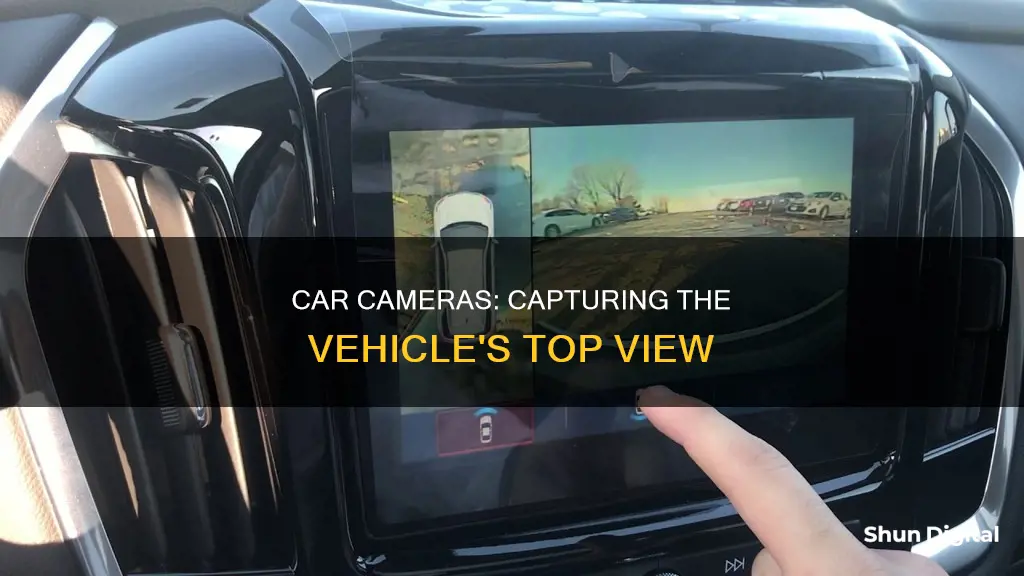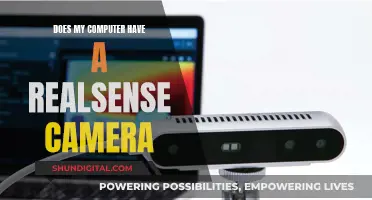
The evolution of automotive technology has led to the development of Advanced Driver Assistance Systems (ADAS), which offer solutions for pedestrian avoidance, traffic sign recognition, lane departure warning, and blind spot detection. One of the most striking applications of ADAS is the 360-degree view car camera, often referred to as a Bird's Eye View Camera. This technology provides drivers with a real-time view of their surroundings, making parking and manoeuvring much easier. The system uses multiple cameras positioned around the vehicle, along with image processing software, to create a top-down view of the car and its surroundings. This computer-generated image is then displayed on the infotainment system screen, providing drivers with a unique perspective that aids in parking and navigating tight spaces.
| Characteristics | Values |
|---|---|
| Number of cameras | 4-6 |
| Camera placement | Front grille, under the side mirrors, near the boot latch, ahead of the front wheels |
| Camera lenses | Wide-angle |
| Camera function | Surveillance of the entire perimeter of the vehicle |
| Image processing | Image stitching, geometric alignment, photometric alignment, composite view synthesis |
| Display | Split-screen, infotainment system screen |
What You'll Learn

Camera placement
Typically, four to six cameras with wide-angle lenses are integrated into the body panel of the vehicle. The specific locations vary slightly between car makes and models but generally include the front grille, under the rear-view mirrors on the sides, and at the rear, often near the boot latch. Some six-camera systems add side-view cameras positioned ahead of the front wheels, enabling drivers to see what is on the other side of obstacles.
The front-facing camera, usually placed in the grille, provides a direct view ahead of the vehicle. The rear-facing camera, in addition to aiding with parking, also functions as the back-up camera, offering a clear view behind the car. The cameras placed in the exterior rear-view mirror areas are typically wide-angle cameras, capturing a broad field of view on either side of the car.
The strategic placement of these cameras ensures that the entire perimeter of the vehicle is under surveillance. The video signals from each camera are then fed into an image-processing program, which stitches the footage together to create a "top-down" or "bird's-eye" view. This composite image is then displayed on the infotainment screen, often with a simulated image of the car included for reference.
Mastering Rocket League Camera Settings: A Guide
You may want to see also

Image stitching
Surround-view or bird's eye view camera systems in cars use multiple cameras placed strategically around the vehicle to provide a top-down view of the car and its surroundings. These systems can use up to six cameras, but typically use four. One camera is positioned in the front, usually in the grille, while two wide-angle cameras are placed in the exterior rear-view mirror areas. The fourth camera is set at the rear of the vehicle and functions as the back-up camera. Six-camera systems add side-view cameras positioned ahead of the front wheels.
The video signals from these cameras are then fed into an image-processing program, which knits together the individual inputs to create a synthetic but positionally accurate top-down view. This process is known as image stitching, where multiple images are combined to create a seamless panorama or a large-scale image.
The next step is to establish the origin point on the vehicle frame of reference, where the coordinates (x, y, z) are all zero. This serves as the reference point for the vehicle frame of reference, and the extrinsic parameters, such as camera position and orientation, are calculated as offsets from this point.
Extrinsic and intrinsic transformations also play a role in image stitching. Extrinsic transformations involve changes in the position and orientation of the camera, while intrinsic transformations relate to adjustments in the camera's optics, such as zoom or focus. Both types of transformations can impact the final stitched image and must be considered.
To stitch images together effectively, finding overlapping features between them is crucial. This process, known as feature matching, ensures proper alignment. Once the overlapping features are identified, homography, a mathematical transformation, is used to map one image to another, creating a seamless panorama.
In the context of car cameras, image stitching allows for the creation of a comprehensive top-down view by combining the inputs from multiple cameras positioned around the vehicle. This technology enhances driver awareness, providing a synthetic bird's eye view of the car and its surroundings, making tasks like parking and manoeuvring in tight spaces much easier and safer.
Georgia's Camera Ticket Policy: What You Need to Know
You may want to see also

Bird's-eye view
Many modern vehicles offer a bird's-eye view camera system, which provides a top-down view of the car and its surroundings. This technology, also known as a surround-view camera system, uses multiple cameras positioned around the vehicle to capture images that are then stitched together to create a composite image.
The number of cameras in a bird's-eye view camera system can vary, but typically there are four cameras. One is positioned at the front of the car, usually in the grille, while two wide-angle cameras are placed in the exterior rear-view mirror areas. The fourth camera is located at the rear of the vehicle and often serves as both the backup camera and the rear-view camera. More advanced systems may include side-view cameras positioned ahead of the front wheels, providing an even more comprehensive view.
The video signals from these cameras are fed into an image-processing program, which combines and analyses the individual inputs to create a seamless, synthetic, yet positionally accurate, top-down view. This composite image is then displayed to the driver, often in lifelike detail, providing a clear understanding of the vehicle's surroundings.
In addition to the basic bird's-eye view, some systems superimpose guidelines onto the image, indicating the vehicle's current orientation and expected direction of travel. More sophisticated setups can even display multiple views simultaneously, such as the front, side, and rear of the car, making tasks like parallel parking much easier and less stressful.
Using Adobe Camera Raw: Is It Free?
You may want to see also

Camera calibration
Car cameras, or ADAS (Advanced Driver Assistance Systems) cameras, are an essential component of modern vehicles, providing enhanced safety and assistance to drivers. These cameras are positioned at various points on the vehicle, including forward-,side- and rear-facing options, to capture images of the vehicle's surroundings. One of the key challenges in ensuring these cameras function effectively is camera calibration.
The importance of calibration is evident when considering the potential consequences of an uncalibrated camera. An ADAS camera that is not properly calibrated may struggle to detect and track objects accurately, leading to potential safety hazards. For example, it may fail to detect obstacles or other vehicles, compromising the effectiveness of features such as lane departure warning, forward collision warning, or automatic emergency braking.
There are several scenarios in which camera calibration is necessary. Firstly, calibration is typically required after any repairs or replacements to the windshield or camera system. Additionally, if there are changes in alignment or airbag deployment, calibration may be mandated by the vehicle manufacturer. It is also recommended to calibrate the camera if there is a noticeable decline in its performance, such as difficulty in detecting objects or a decrease in the accuracy of its responses.
The camera calibration process can vary depending on the specific requirements of the vehicle and the camera system. There are two common types of calibration: static and dynamic. Static calibration involves mounting a specific target image in front of the vehicle during the process, while dynamic calibration requires driving the vehicle at a set speed on well-marked roads. The calibration process typically takes an hour or more and should be performed by trained technicians to ensure accuracy and safety.
Minolta X-700: What Battery Powers This Classic Camera?
You may want to see also

Feedback mechanisms
One of the primary feedback mechanisms employed by these systems is audio alerts. When the car's cameras detect nearby objects within a certain proximity, the system generates an audible warning, alerting the driver to the potential hazard. This feature is particularly useful when manoeuvring in tight spaces or when visibility is limited, such as during parallel parking.
In addition to audio alerts, some advanced systems also incorporate haptic feedback. This feature provides a physical sensation, such as a vibration in the steering wheel or the driver's seat, to further emphasise the presence of nearby objects. Haptic feedback adds an extra layer of awareness and can help prevent collisions, especially when the driver's attention may be focused elsewhere.
Another feedback mechanism utilised by surround-view camera systems is the use of guidelines or dotted lines superimposed onto the image displayed on the infotainment screen. These lines provide a visual representation of the vehicle's current orientation and expected path based on factors such as gear selection and steering-wheel angle. By offering this visual feedback, the system helps drivers better understand their vehicle's position relative to surrounding objects, making it easier to navigate tight spaces and avoid obstacles.
The accuracy of these feedback mechanisms relies on the proper calibration of the cameras and the effective stitching together of the camera feeds. Each camera has a specific angle, position, and field of view, and the system's computer combines these inputs to create a cohesive top-down view. Proper calibration ensures that the images are aligned correctly and that the colours are consistent, providing a seamless and accurate representation of the surroundings.
In conclusion, feedback mechanisms in car surround-view camera systems play a crucial role in enhancing driver awareness and safety. By utilising audio alerts, haptic feedback, and visual guidelines, these systems provide valuable information about the vehicle's surroundings, helping drivers navigate tight spaces and manoeuvre with confidence. The effectiveness of these mechanisms relies on the accurate calibration and synchronisation of multiple camera inputs to create a seamless and informative top-down view.
Boston's Surveillance Camera Network: How Many Are Watching?
You may want to see also
Frequently asked questions
Car cameras use multiple cameras placed around the car to capture footage of the car and its surroundings. This footage is then stitched together using image-processing software to create a top-down view of the car. The top-down view is a simulation that provides a bird's-eye view of the car and its surroundings, making it easier for the driver to navigate and park.
A typical car camera system uses four cameras positioned at the front, rear, and sides of the car. However, some systems may use up to six cameras, with additional cameras placed ahead of the front wheels to provide a better view of obstacles.
Car camera systems, also known as surround-view or 360-degree camera systems, offer several advantages. They provide a bird's-eye view of the car and its surroundings, making it easier for drivers to navigate and park their vehicles, especially in tight spaces. These systems also improve safety by helping drivers spot pedestrians, children, and obstacles while reversing or manoeuvring.







